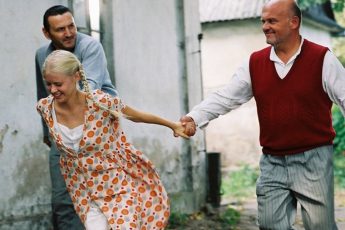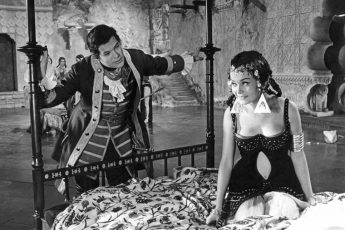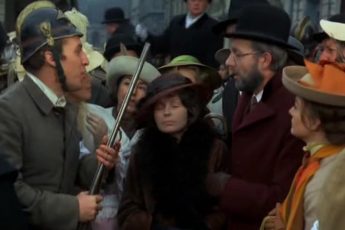Conservatism and Intellectual Elites
Andrzej Wajda’s The Wedding (Wesele, 1973)
Vol. 46 (October 2014) by Moritz Pfeifer
Last month, I wrote a review about the final work of late Russian filmmaker Alksei German, Hard to Be a God, in which a group of scientists are sent to an earth-like planet which is stuck in the Middle Ages with the task to provoke a Renaissance there. The basic flaw of the movie, I argued, is that it does not closely enough follow the original idea of the Strugatsky brothers, on whose novel the film is based. The writers use the sci-fi setting to ask a political question: in what ways are a bunch of scientists trying to liberate an oppressed foreign society different from the authoritarian structures controlling it? The filmmaker ignores this question, seeking contemporary parallels only in the degenerate medieval society which he presents to the viewer in endless depictions of drinking orgies and delusional festivities. Where the book tries to find out what keeps people from changing history, the film simply demonstrates that they are stupid.
Both thematically and aesthetically, a similar problem seems to come out of Andrzej Wajda’s The Wedding, which is based on a drama written at the turn of the century by Stanisław Wyspiański. The play is also concerned with questions of class struggle, individual and national freedom, and the disillusion of an intellectual elite to bring about social change. Like the novel of the Strugatsky brothers, Wyspiański uses symbols to refer to a reality which viewers of the time could immediately recognize but which would have put the author in a difficult position if the story was told point-black. Wajda’s version, similar to Aleksei German’s adaptation of Hard to Be a God, largely ignores the political meaning of these symbols and focuses instead on a virtuosic representation of a bunch of drunken wedding guests haunted by visions of a traumatic past. Ironically, both films thus exemplify the very inability to criticize the system ridiculed by the writers on whose respective works they are based.
Wyspiański’s play opens with a wedding between a bourgeois intellectual from Kraków and a peasant girl from a nearby village (Wyspiański actually lived similar events himself when a fellow Krakówian poet called Lucjan Rydel married a village girl and many of the characters in the play directly refer to real people of the fin-de-siècle Krakówian society). These conjugal arrangements were not uncommon during the time. In the second half of the 1800s, Polish intellectuals became increasingly fascinated with Polish peasantry (aka. chłopomania, lit. “peasant mania”). Some even had Romantic aspirations for the large peasant population to participate in the Polish national movement, as Poland was partitioned between the Habsburg Monarchy, Prussia and the Russian empire throughout most of the 19th century.
The play starts off realistically. Although written in verse, the peasants speak the dialect of the Kraków region while the Krakówians converse in an exalted lingo demonstrating their intellectual superiority. As the wedding guests drown in alcoholic mist, they start having mythological and historical visions. The groom is the first to see a “Black Knight” who is symbolic for Poland’s past military glory. Second is the journalist, who sees a court jester called Stańczyk (c. 1480–1560) active under the reign of King Alexander, King Sigismund the Old and King Sigismund Augustus. The third vision introduces itself to the guests as “the Devil” but a peasant recognizes Jakub Szela (1787-1862 or 1866) who was a Polish leader of the pro-Austrian peasant uprising in Galicia of 1846. Finally, there is the “Ghost of Wernyhora” who presents a golden horn to the Host symbolizing the national movement and calls the guests to a revolt. One of the farmers is dispatched to sound the horn at each corner of Poland, but loses the Horn and with it the aspirations for a social movement.
The tricky aspect of these visions is to think that they are meant to by purely symbolic and that there is, supposedly, some kind of formal shift going on from Realism to Symbolism (as suggested for instance in Paul Coates’ otherwise very informative article).1 Intellectuals of the time really had such fantasies especially in the attempt to create a nation state with a coherent mythological architecture. All European national movements of the 19th century sought out myths and artists and intellectuals were especially well equipped to popularize them (think of Wagner’s rediscovery of Germanic mythology). The only symbolic aspect of these visions is perhaps that they are experienced as nightmares (the revolutionary leader becomes the devil, the Horn of collective action falls silent, etc.). But even this seems to have a realistic side to it, at least in Freud’s sense of an unconscious reality. Wyspiański’s play thus unmasks the dreams of intellectuals. He reveals that their political ethos is based on military superiority, a quasi-religious belief in national myths (which makes them as intellectually immature as the God-fearing docile villagers), and a deeply narcissistic form of Conservatism. The latter gets expressed by Journalist’s now proverbial “Let there be war the whole world over/As long as the Polish countryside is quiet/As long as the Polish countryside is calm” (“Niech na całym świecie wojna/ byle polska wieś zaciszna/ byle polska wieś spokojna”). The peasants are mere objects of projection for the intellectual community to stage social upheaval while staying in safe distance from the necessary actions through which that change could be achieved. Wyspianski was visionary enough to feel that the dream of Romantic nationalism is everything but idyllic, not even in the context of a marriage on the countryside. In fact, part of it fostered the national and racial discrimination that would lead to the First World War fourteen years later.
It is not hard to see how Wajda could have made sense of this material for the Polish society of the 1970s. By that time, dreams about the change Socialism could have brought about were as ghastly as the 19th Century visions of a Polish nation state. The economic differences between the Eastern and Western sides of the Iron Curtain started to grow and Poland, like other countries of the Eastern Block, had to take up large amounts of foreign debt to keep up its industry and living standards. “What does ‘Socialism’ mean?”, was the beginning of a popular joke in Poland in the 1970s. The answer: “The longest road from Capitalism to Capitalism”. Discontent with Communism started to spread among the intelligentsia. In 1968 the Communist party split and a conflict between the “newly educated” faction consisting of worker’s and peasant’s children stood up against the old guard. But the nationalistic and anti-Semite rhetoric of the party made it impossible for revisionists to work within the party. At the same time, in March 1968, a student movement emerged out of anti-government protests represented by such figures as Adam Michnik, Jan T. Gross or Leszek Kołakowski. However, protesters were isolated, shut down, and often emigrated. The end of the 1960s is thus often characterized by stagnation and a lack of utopia. The poet and essayist Adam Zagajewski adequately described the years between 1968 and 1970 as a “dreamtime for pessimists and worriers”2. Similar to the fin-de-siècle intellectual elite caricatured by Wyspiański, the intellectual elite of the late 1960s and early 1970s was not actively involved in finding ways out of the political crisis. The picture of the suppressed student protests as well as the fact that a majority of intellectuals looked indifferent or distanced to the incidents around – and sometimes even let themselves be instrumentalized against the students – do not work well with the picture of a resistant Poland.
It may be that Wajda thought about Wyspianski’s play because it most poignantly explains the reasons for this kind of intellectual inertia. It is rather hard to read this from his film, however, which focuses excessively on the delusional experiences of the partying crowd whose visions fail to come across as mirrors of their political drowsiness. Early on, Wajda films the wedding party as if in a carousel, establishing a continuous feeling of unbalance and chaos. This makes it harder for him to convincingly suggest that the visions the guests are seeing are not simply instances of the supernatural standard of their daily grind but of their own feared political unconscious which is allowed to surface only when self-awareness is clouded by alcohol. It is uncertain whether Wajda’s wedding party recognizes the visions as their own at all. In the film, they look more like manifestations of a fool’s paradise, the historical specters at best an external call to remember the course Poland’s history is supposed to take (in the manner of The Lion King’s “Simba! Remember who you are!”). Ironically this undermines the original work in which historical memory is manipulation for a misguided political idea. Wajda reduced Wyspianski’s play to a critique of self-satisfied smugs who are being fooled by a system escaping them. But where Wyspianski dissected the psychological incentives behind political passivity, Wajda seems to think that the problem of his generation is people preferring drinking and dancing to political upheaval.
This may be the reason why so many critics dismissed the work as lacking “an organizing idea”3 which had, coincidentally, also been a major criticism of Aleksei German’s film (Hollywood Reporter’s Deborah Young, for instance, described this work as “nearly incomprehensible”4). A more recent adaptation of The Wedding by Wojciech Smarzowski set in 2004 succeeds in keeping the original political referentiality of the play alive by having it take place in transitional Poland. Here, the political context is neoliberalism and the divide between the newly rich and the poor. While this film manages to establish meaningful symbolic specters – most of them variations on the theme of money – it sacrificed the play’s original question of the role of intellectuals with regards to social change and political responsibility.




Great article, thank you! I am only not sure if the 2014 movie by Smarzowski was intended as an adaptation of Wyspiański; it’s rather a contemporary text created within this Polish tradition of portraying our society at the wedding.